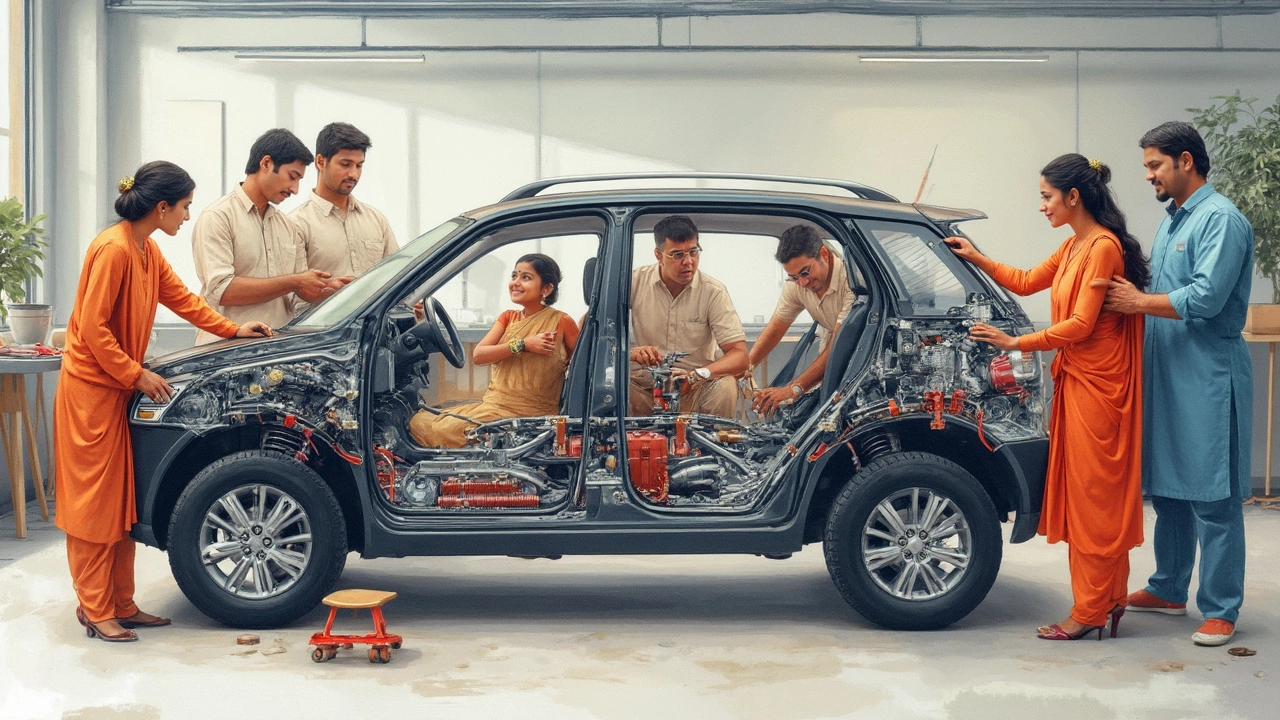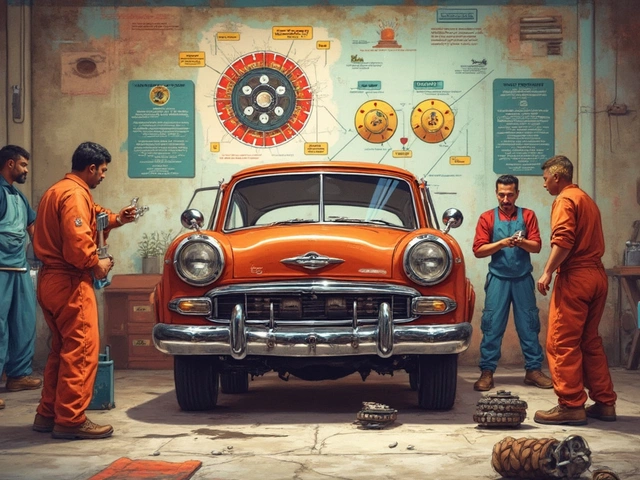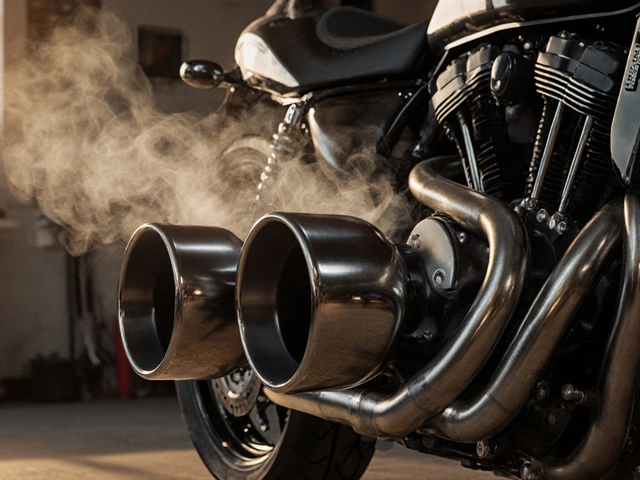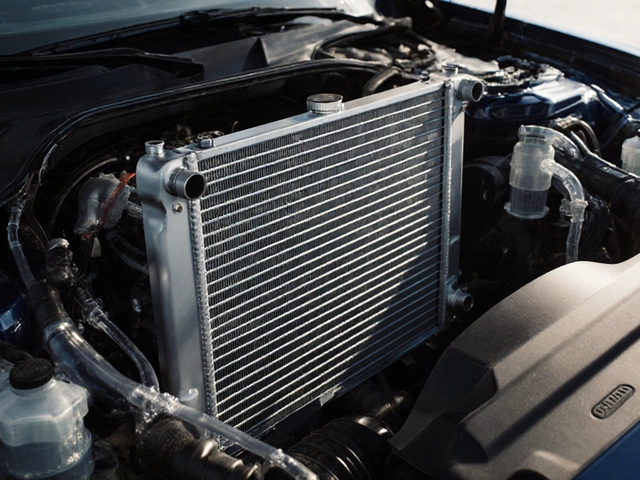
Ever wonder why your car handles bumps like a pro... or why it feels every single pebble on the road? It's all about the suspension system. This collection of parts works together to make sure your tires stay connected to the road, providing a smooth ride and decent control. Curious about what exactly makes up this unsung hero of car mechanics? Let’s break it down.
At the heart of every suspension system are the springs and shocks. These bad boys absorb the impact from road imperfections, like potholes or sudden dips, giving you that cushy feeling while driving. And here’s a nugget: Different cars use different types of springs—coil springs, leaf springs, even air springs in some luxury rides. Each type has its own style, perks, and quirks.
- Understanding Suspension Basics
- Springs and Shocks
- Control Arms and Ball Joints
- Bushings and Anti-Roll Bars
- Signs of Wear and Tear
- Tips for Upgrading Suspensions
Understanding Suspension Basics
Think of a car's suspension system as the hero keeping everything balanced. Without it, every drive would be a bone-rattling experience. So, what's going on under the hood?
At its core, a suspension system connects the car body to the wheels through a series of joints, springs, and dampers. Its main job is to optimize tire contact with the road, which ensures better control and minimizes wear and tear. A fun fact: the first real suspension systems were invented to help horse-drawn carriages travel more smoothly. Fast forward to today, and you've got systems that can adjust on the fly to changing road conditions.
Let's break this down:
- Springs: These are your primary shock absorbers. Coil springs are most common, found in just about every car out there, but you might see leaf springs in trucks or air springs in high-end models. Each works a little differently, but the goal is the same—keeping your ride smooth.
- Shocks and Struts: While springs take the edge off the bumps, shock absorbers or struts control the rebound. Without them, you'd feel like you're on a pogo stick.
Did you know: In a typical passenger car, the suspension system is designed to handle up to twice the vehicle's weight in force when hitting bumps? That's pretty wild and shows just how important these components are.
What about the configuration? Most cars use independent suspension for at least the front wheels, meaning each wheel moves separately. This offers better handling—important when you're speeding around sharp curves or trying to find a parking spot.
When figuring out what's under your car, identifying these components and understanding their roles can help you make better maintenance choices. Stay tuned as we get into the nitty-gritty of how these parts work together in upcoming sections!
Springs and Shocks
Springs and shocks are the backbone of your car's suspension system. They work together to manage that bumpy relationship between the road and your vehicle. Think of springs as your car’s first line of defense. They absorb the initial impact from a bump or dip, ensuring your car doesn't immediately feel the jolt. There are a few main types of springs you might find in vehicles.
Coil springs are the most common. They're those tightly wound metal spirals nestled between the body and the wheels. They’re durable, flexible, and found in everything from sedans to sports cars. Leaf springs, meanwhile, look like flat layers of metal stacked together. You’ll see these often in trucks and older cars—they’re designed to handle heavier loads.
Luxury cars sometimes use air springs, which, as the name suggests, use air compression for a smoother, customizable ride.
Now, let's talk about shocks, officially known as shock absorbers. These guys take the energy from your springs and dampen it, converting it to heat and releasing it. That way, your car doesn't end up bouncing endlessly after hitting a bump. In simple terms, they keep the ride smooth and stable.
You might come across struts, which are like shocks but with a bonus feature. They add structural support to the suspension parts. Struts are often found in the front of many front-wheel drive vehicles.
- Signs your shocks might need replacing include: bouncing or swaying during turns, nosedives during braking, or uneven tire wear.
- Many shocks last 50,000 miles, but if you're feeling every crack in the road, it might be time for a check-up.
Here’s a little tip: If you’re into DIY car maintenance, replacing coil springs or shocks can be done at home with the right tools, like a spring compressor, but it demands careful attention—those springs carry a lot of tension.
By keeping tabs on your vehicle suspension, you ensure a smooth ride and boost the lifespan of your car's tires and other parts. So, while it might seem like the springs and shocks are just there to cushion the ride, they're actually doing a lot of heavy lifting. Literally!
Control Arms and Ball Joints
Picture the suspension system as the backbone of your vehicle, keeping everything aligned and in place—here's where control arms and ball joints come into play. Control arms are those metal links that connect the wheel hubs to the frame of your car. They ensure that wheels move up and down in a controlled way, rather than bouncing all over the place.
You usually find two types of control arms on most vehicles: upper control arms and lower control arms. Both are crucial for maintaining proper alignment and handling. You've probably never noticed them, but without them, let's just say your driving experience would be way different, and not in a good way.
Then we have ball joints, which are like the hips for your car's legs. They allow the control arms and wheel assemblies to move up and down and pivot left and right. Think of them as the knees that keep everything moving smoothly without getting out of whack. Keeping these parts in good condition is key to your car’s performance.
| Component | Function |
|---|---|
| Control Arms | Connect wheel hubs to the vehicle frame and help with suspension alignment |
| Ball Joints | Allow the wheels to move up and down while steering |
If you're experiencing squeaks or clunks when taking turns or hitting bumps, it’s time to check those ball joints or control arms—they could be wearing out. Swapping them out might seem pricey, but consider it an investment in avoiding more expensive repairs down the road. If you're a DIY enthusiast feeling adventurous, some folks do replace these parts themselves, but make sure you've got the right tools and know-how before trying!

Bushings and Anti-Roll Bars
Now, let's chat about bushings and anti-roll bars. These might not sound as flashy as shocks and struts, but they play a key role in your car's suspension system. Bushings are little cushions made of rubber or polyurethane that absorb shocks and vibrations between metal parts. They're like the peacemakers, helping your car's suspension parts get along without squeaking and clanking like an old bedframe.
These unassuming parts have a big job: They keep alignment in check and minimize friction. If your car is feeling wobbly or you're hearing strange noises while turning, worn bushings could be the culprits. They’re small but mighty, and replacing them can really sharpen up handling.
On the topic of anti-roll bars (also known as sway bars), their mission is to keep your car flat and stable when you take corners. Imagine driving around a sharp curve—without anti-roll bars, you'd feel your car leaning more, making it less stable. These bars connect the left and right side of your suspension, reducing body roll by distributing weight more evenly.
- Fun fact: Some performance cars have adjustable anti-roll bars, letting drivers fine-tune their ride for track days or daily driving.
- Typical signs you need to check your anti-roll bars include clunking noises during turns or imprecise steering.
Thinking about upgrading? Replacing old bushings with high-performance polyurethane ones can improve handling. Also, beefier anti-roll bars can make a huge difference if you love carving those corners.
Here's a little insider tip: If you're after a smoother ride without compromising on handling, consider upgrading these parts. Quality components can turn your daily commute into a less bumpy adventure.
Signs of Wear and Tear
Recognizing when your suspension parts need some attention can save you a lot of hassle down the road. But how do you know when it's time to check things out? Here are some tell-tale signs.
First off, if your ride feels more like a rollercoaster than a smooth drive, bouncing around in your seat, that's a major hint something’s up with the car suspension. Poor shock absorbers might be causing excessive movement.
Another clue? Uneven tire wear. When your suspension is compromised, it can't keep the tire evenly pressed against the road. It’s not just about comfort—it’s a safety thing, too.
- Does your car pull to one side? It might be due to uneven tire pressure, but often it's because of worn-out suspension components.
- Don't ignore the clunks or knocks. If your vehicle sounds like it’s got a drum set hidden underneath, it could mean trouble with parts like the control arms or ball joints.
- Pay attention to steering issues. Loose or difficult steering can indicate that the suspension needs a check.
How about performing a quick bounce test? With the car parked, give one corner a push down. When you let go, a healthy suspension should bounce back only once or twice. More than that? Time for a check-up.
And if you’re still on the fence, here’s a stat: According to a recent auto safety survey, nearly 40% of drivers delayed repairs on vehicle suspension problems, leading to bigger issues and costs down the line. So, staying on top of these signs can save you both money and stress.
Tips for Upgrading Suspensions
If you're itching to give your ride a boost, upgrading your suspension system can be a game-changer. Whether you're after better handling or a smoother ride, there’s a lot to consider. Let’s dive into the essentials to keep your vehicle in top form.
First up, think about what you really want from the upgrade. Do you crave tighter control on those winding roads? Then maybe performance shocks or struts are the way to go. Prefer to float over bumps like they're not even there? Consider upgrading your springs to something softer or even looking into air suspension systems. They give you the flexibility to adjust the ride height and stiffness, which is pretty sweet.
- Budget Wisely: Before you start splurging, set a budget. It’s easy to get carried away when there are so many shiny options out there. A basic spring and shock upgrade can make a noticeable difference without breaking the bank.
- Research Your Parts: Not all parts are created equal. Check reviews and talk to folks who’ve used the parts you’re eyeing. You don’t want to invest in something that others have regretted.
- Compatibility is Key: Double-check that your chosen parts will fit your vehicle. It sounds obvious, but you'd be surprised how frequently this little detail gets overlooked.
- Think Long-Term: An upgrade might do wonders today, but think about its long-term impact. Will it increase tire wear or mess with alignment? Some tweaks may mean additional ongoing maintenance costs.
- DIY or Professional Help: Are you handy with a wrench? If not, it might be wise to get a pro involved, especially with complex systems like air suspensions.
Also, here’s a nifty tip: Keep an eye on weight distribution when upgrading. If you add components that weigh more than the originals, you might need to offset that elsewhere. Keeping the car balanced is super important for handling.
Finally, don’t forget to enjoy the process. Upgrading your car suspension is like tailoring a suit—it’s all about finding that perfect fit that complements your style (and, well, road presence). So take your time, do it right, and soon you'll have a ride that's not just transport but an experience.




